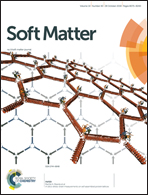Adsorption and fusion of hybrid lipid/polymer vesicles onto 2D and 3D surfaces†
Abstract
We investigated the formation of hybrid lipid/polymer (1,2-dioleoyl-sn-glycero-3-phosphocholine and poly(ethylene oxide-b-butadiene); DOPC/EO22Bd37) films onto planar silica surfaces. Using laser scanning confocal microscopy, atomic force microscopy, and quartz crystal microbalance analysis, we monitored the adsorption and fusion of hybrid lipid/polymer vesicles onto planar borosilicate glass cleaned via chemical etching or RF/air plasma treatment. In addition we used cryo-electron microscopy to characterize film formation on mesoporous silica nanoparticles. As the polymer content in the vesicles increased, the resulting hybrid lipid/polymer films on borosilicate glass – cleaned by chemical etching or plasma treatment – were more heterogeneous, indicating a large number of adsorbed vesicles rather than continuous bilayer films at higher polymer loadings. The observed lateral fluidity of both DOPC and hybrid lipid/polymer films also decreased substantially with increasing polymer fraction and was found to be relatively insensitive to changes in pH. Films prepared from vesicles with higher polymer loadings were completely immobile. We also found that polymer vesicles did not interact with clean plasma-treated glass surfaces, which may be due to elevated OH and Si–OH on plasma-treated surfaces. Conformal hybrid lipid/polymer coatings consistent with bilayers could be formed on mesoporous silica nanoparticles and imaged via cryo-electron microscopy. These results expand the library of biocompatible materials that can be used for coating silica-based materials and nanoparticles.



 Please wait while we load your content...
Please wait while we load your content...
